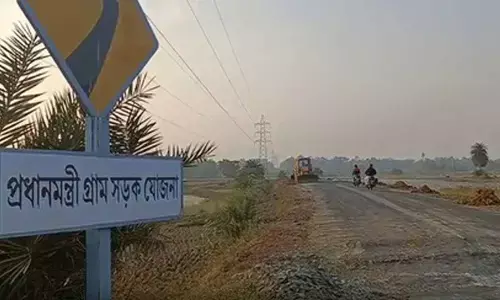Solar lights for Chamunda trail in HP; solar fencing for farmers to bar strays
Share :

The Himalayan state of Himachal Pradesh, where farming communities are vulnerable to the effects of climate change, is focusing on a renewable energy transition -- the path to keep 1.5 degrees Celsius in reach.
Shimla: The Himalayan state of Himachal Pradesh, where farming communities are vulnerable to the effects of climate change, is focusing on a renewable energy transition -- the path to keep 1.5 degrees Celsius in reach.
Himachal Pradesh aims to become a ‘Green Energy State’ by 2026, with assistance from the World Bank that showed interest in taking forward the Green Resilient Integrated Development programme with a Basin Approach, at an estimated cost of Rs 2,500 crore.
It is pegged to be one of the largest renewable agendas planned by Himachal Pradesh, a state where more than 90 per cent of the population resides in rural areas.
As a step towards sustainability, authorities in Kangra District have used solar lights to illuminate the steep path that leads to the ancient Adi Himani Chamunda Temple on the hilltop.
A total of 101 solar lights were installed by the district administration last year and the trail of lights is a spectacular sight after sunset.
The Himachal Pradesh Government aims to make two panchayats each in all 12 Districts a ‘Green Panchayat’ on a pilot basis by commissioning solar power projects with a capacity ranging from 500 KW to 1 MW.
A solar power-based Battery Energy Storage System project will be set up in remote Pangi in Chamba District to augment the power supply system in this tribal belt.
Also, hydropower generator SJVN Ltd, a joint venture between the Union Government and the Himachal Pradesh Government, is executing five solar power projects in the hill state.
The Himachal Pradesh Government is giving 40 per cent subsidy to the youth of the state to set up solar power projects with a generation capacity ranging from 250 KW to 2 MW on their own plots or leased land.
The electricity generated from these projects will be purchased by the State Electricity Board.
As over 90 per cent of state’s population resides in rural areas, a whopping 70 per cent of the populace is dependent on agriculture and horticulture as a source of livelihood. However, crop losses owing to monkeys, wild boars, blue bulls and other wild animals are high.
To alleviate this problem, the state government is promoting solar-powered electric fences in order to keep the stray animals at bay.
The state government provides a subsidy of 85 per cent if three or more farmers want to build a solar fence around their fields. For individual farmers looking to solar fence their farm, the subsidy provided is 80 per cent.
The current in the electric fence around the farms that is powered by solar panels at regular intervals, is enough to keep stray animals, wildlife and monkeys away from the crops.
As per official data, the Himachal Pradesh Council for Science, Technology and Environment (HIMCOSTE) has also identified ten schools for setting up grid-connected solar power plants to propagate the concept of energy conservation in schoolchildren.
Grid-connected solar rooftop power plants that can generate 18.86 MW of electricity have been installed by HIMURJA in the state. This will result in savings of Rs 12.50 crore annually and will offset 13,140 tonnes of the state’s carbon footprint, says the state's Economic Survey 2022-23.
In addition, 3.98 MW off-grid solar power plants and 38.10 MW ground-mounted solar power projects have been commissioned in Himachal.
Under the Rs 2,000 crore-Himachal Pradesh Power Sector Development Programme, launched with the help of the World Bank, there is a provision to construct solar power projects with a capacity of 200 MW and to build 11 substations and two distribution lines serving 13 towns.
Set up to develop the skills of the local youth, the Himachal Pradesh Kaushal Vikas Nigam is training 500 people in the solar energy sector from this fiscal.
In November last year, the Centre, the Himachal Pradesh Government and the World Bank inked a $200 million project that will facilitate power sector reforms in the state and increase the share of renewable energy in its electricity generation.
This will contribute to Himachal’s overall aim of augmenting its renewable energy capacity by 10,000 MW to make its power supply greener.
In a major green push, the state transport department in February 2023 changed its entire fleet of official vehicles from petrol and diesel-run ones to Electric Vehicles (EVs).
To promote EVs on a large scale, Government departments stopped buying diesel or petrol vehicles from January 1 and if there is a necessity to buy fossil fuel-run vehicles then the departments can do that only after the approval of the Cabinet.
Due to the efforts of the government, the number of official EVs has reached 185, while there are 2,733 private EVs in the state.
Chief Minister Sukhvinder Sukhu, who is monitoring the clean energy agenda, is leading by example and uses an EV himself.
Also, all the diesel buses of the Himachal Road Transport Corporation (HRTC) are being converted into e-buses in a phased manner, a government spokesperson told IANS.
The state also has the distinction of being a net exporter of power with 100 per cent renewable energy.
As hydropower faces a number of challenges, the state has changed its hydropower policy after 15 years with focus on biomass and solar power development.
As per the World Bank, the state currently meets more than 80 per cent of its energy demands from hydropower.
Himachal Pradesh’s hydropower generation potential is 23,500 MW -- about 25 per cent of the country’s total hydropower potential. A total of 10,580 MW has already been harnessed, says the Economic Survey 2022-23.












